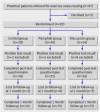Effect of providing information about normal test results on patients' reassurance: randomised controlled trial
- PMID: 17259186
- PMCID: PMC1800996
- DOI: 10.1136/bmj.39093.464190.55
Effect of providing information about normal test results on patients' reassurance: randomised controlled trial
Abstract
Objective: To investigate whether providing information about normal findings before a diagnostic test improves patients' reassurance and reduces anxiety about symptoms.
Design: Randomised controlled trial.
Setting: Outpatient cardiology clinic.
Participants: 92 patients with chest pain referred for a diagnostic exercise stress test.
Intervention: Before undergoing testing patients were randomised to receive standard information (n=28; control group), a pamphlet explaining the function of the test and the meaning of normal test results (n=30; pamphlet group), or the pamphlet and a brief discussion about the meaning of normal test results (n=34; discussion group).
Main outcome measures: The primary outcome was patients' reported reassurance on a 5 item scale immediately after the test and at one month. Secondary outcomes were the proportion of patients still with chest pain and still taking cardiac drugs at one month.
Results: The mean levels of reassurance after testing and feedback from the doctor were significantly higher in the discussion group (42.0, 95% confidence interval 39.7 to 44.2) than in the pamphlet (39.2, 36.1 to 42.3) and control groups (35.8, 31.6 to 39.9). This difference was maintained at one month. The proportion of patients still reporting chest pain at one month decreased significantly in the discussion group (to 17%) and pamphlet group (to 28%) but not in the control group (to 36%). A trend was for fewer patients in the discussion group to be taking cardiac drugs at one month.
Conclusion: Providing patients with information about normal test results before testing can improve rates of reassurance and reduce the likelihood of future reports of chest pain.
Trial registration: Current Controlled Trials ISRCTN87589121 [controlled-trials.com].
Conflict of interest statement
Figures
Comment in
-
Reassuring patients about normal test results.BMJ. 2007 Feb 17;334(7589):325. doi: 10.1136/bmj.39121.361910.80. BMJ. 2007. PMID: 17303841 Free PMC article.
Similar articles
-
An intervention to reassure patients about test results in rapid access chest pain clinic: a pilot randomised controlled trial.BMC Cardiovasc Disord. 2014 Oct 4;14:138. doi: 10.1186/1471-2261-14-138. BMC Cardiovasc Disord. 2014. PMID: 25280578 Free PMC article. Clinical Trial.
-
Does the early feedback of results improve reassurance following diagnostic testing? A randomized controlled trial in patients undergoing cardiac investigation.Health Psychol. 2015 Mar;34(3):216-221. doi: 10.1037/hea0000109. Epub 2014 Aug 18. Health Psychol. 2015. PMID: 25133827 Clinical Trial.
-
The value of diagnostic information to patients with chest pain suggestive of coronary artery disease.Med Decis Making. 2005 Mar-Apr;25(2):149-57. doi: 10.1177/0272989X05275157. Med Decis Making. 2005. PMID: 15800299
-
A critical pathway for patients with acute chest pain and low risk for short-term adverse cardiac events: role of outpatient stress testing.Ann Emerg Med. 2006 May;47(5):427-35. doi: 10.1016/j.annemergmed.2005.10.010. Epub 2006 Feb 8. Ann Emerg Med. 2006. PMID: 16631982
-
A preoperative education intervention to reduce anxiety and improve recovery among Chinese cardiac patients: a randomized controlled trial.Int J Nurs Stud. 2012 Feb;49(2):129-37. doi: 10.1016/j.ijnurstu.2011.08.008. Epub 2011 Sep 22. Int J Nurs Stud. 2012. PMID: 21943828 Clinical Trial.
Cited by
-
Nursing Students' Experiences with Computer Simulation-Based Communication Education.Int J Environ Res Public Health. 2021 Mar 17;18(6):3108. doi: 10.3390/ijerph18063108. Int J Environ Res Public Health. 2021. PMID: 33803034 Free PMC article.
-
Emergency Medicine Clinician Experiences Addressing Uncertainty in First-Trimester Bleeding.J Patient Exp. 2022 Nov 22;9:23743735221140698. doi: 10.1177/23743735221140698. eCollection 2022. J Patient Exp. 2022. PMID: 36452258 Free PMC article.
-
"Doctor, please tell me it's nothing serious": an exploration of patients' worrying and reassuring cognitions using stimulated recall interviews.BMC Fam Pract. 2014 Apr 23;15:73. doi: 10.1186/1471-2296-15-73. BMC Fam Pract. 2014. PMID: 24762333 Free PMC article.
-
GPs' perspectives on diagnostic testing in children with persistent non-specific symptoms: a qualitative study.Br J Gen Pract. 2025 Jan 30;75(751):e105-e112. doi: 10.3399/BJGP.2023.0683. Print 2025 Feb. Br J Gen Pract. 2025. PMID: 38950942 Free PMC article.
-
Adaption, implementation and evaluation of collaborative service improvements in the testing and result communication process in primary care from patient and staff perspectives: a qualitative study.BMC Health Serv Res. 2017 Aug 30;17(1):615. doi: 10.1186/s12913-017-2566-8. BMC Health Serv Res. 2017. PMID: 28854919 Free PMC article.
References
-
- Howard L, Wessely S. Reappraising reassurance: the role of investigations. J Psychosom Res 1996;41:307-11. - PubMed
-
- Potts SG, Bass CM. Psychological morbidity in patients with chest pain and normal or near normal coronary arteries: a long-term follow-up study. Psychol Med 1995;25:339-47. - PubMed
-
- Donkin L, Ellis CJ, Powell R, Broadbent E, Gamble G, Petrie KJ. Illness perceptions predict reassurance following negative exercise testing result. Psychol Health 2006;21:421-30.
Publication types
MeSH terms
Associated data
LinkOut - more resources
Full Text Sources
Medical


